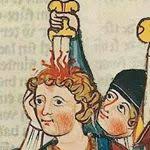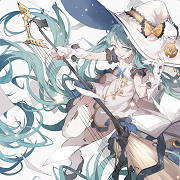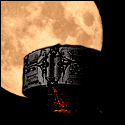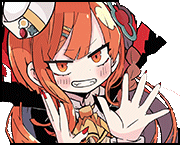|
The dm could also just give you a challenging fight on purpose, have you considered that?
|
|
|
|

|
| # ? Jun 5, 2024 17:31 |
|
Deteriorata posted:I know it isn't real, but it needs to feel real for proper immersion aka verisimilitude. If I go into every battle confident that the DM has fixed every encounter to be winnable, it just feels like a video game and stops being immersive. It becomes something I'm playing and not something I'm doing. CR being not much better than a random number has literally nothing to do with this, you can have a random table of encounters including ones that are too strong for the party even if you had perfectly accurate CR
|
|
|
|
Deteriorata posted:I know it isn't real, but it needs to feel real for proper immersion aka verisimilitude. If I go into every battle confident that the DM has fixed every encounter to be winnable, it just feels like a video game and stops being immersive. It becomes something I'm playing and not something I'm doing. What do you think the purpose of challenge rating is? Do you think the default assumption is that a "balanced" encounter is one that players are guaranteed to win? Do you not think it's possible to use those numbers to make a fight that might provide the feel or challenge that you want? I'm just baffled by the implication here that making CR actually do its job would in fact be a bad thing. If it did, it would be easier for the DM to give you what you want because they could easily add extra challenge without accidentally adding, for example, a creature that's completely immune to everything your party can do. I'm not even going to address versimiltude here because I think that's inherently worthless. The Deleter fucked around with this message at 21:59 on Jan 21, 2023 |
|
|
|
It's important that even encounters that are meant to be easy could accidentally turn out too hard, or maybe hard ones too easy. It's important that this occur by accident, and against the DM's will. Doing it on purpose is like a video game, unlike the opposite which videogames never do because of busted mechanics or balance issues. Imagine, fighting an enemy that's too strong and being forced to run away! A videogame could NEVER do that.
|
|
|
|
The incredibly binary win states of D&D sure don't help, either. If you lose, you Die. You likely won't know you need to retreat until enough of the party goes down, at which point if you abandon them they probably die. Many monsters tough enough to kill you also have options to continue killing you as you retreat, whether using ranged weapons and spells, flat-out outrunning you, or being in their home environment they know far better than you. Outcomes besides a TPK are basically mercies or contrivances on the DM's part, and unless the enemy is explicitly non-lethally knocking your characters out you're going to start eating those death saves. Information like how close you are to killing an enemy (when that HP difference can be all the difference between a foe with some lucky roles and an enemy genuinely out of your league) are, again, mercies and contrivances on the DM's part, especially with no obligation to include a marker like 4E's Bloodied. D&D is not a system that does what you're asking for well. Not without an aware and on the ball DM, who would be greatly served by a CR system that actually gives him useful information!
|
|
|
|
It ruins the game for me if the rules work like the book says. In order for me to have fun the ruelbook should be filled with traps for the DM and players. Basically, I'm dumb as a sack of hammers, just a real jackass.
|
|
|
|
I mean I really wish the CR was a useful tool, but they way they did it (at least in 5e) means it isn't. So it falls to DMs to feel it out, which is a barrier to players and DMs alike. It's not insurmountable, and ultimately I'm just living with it because my opinion on the matter doesn't actually matter to WotC. The best thing I can do is change the game at my home table to make it better for myself, and then share what worked for me with other people who are trying to do the same. It kinda sucks that that's the situation but what else am I gonna do?
|
|
|
|
Deteriorata posted:I know it isn't real, but it needs to feel real for proper immersion aka verisimilitude. If I go into every battle confident that the DM has fixed every encounter to be winnable, it just feels like a video game and stops being immersive. It becomes something I'm playing and not something I'm doing. Chances are, some of the most fun encounters you've had as a player were fixed in some way by the DM. I hate to say it, but it's the honest truth. DMing is an illusion, and sometimes the dice tell a really lovely story, especially in a binary pass/fail system like D&D. To prevent inexperienced DMs from making easy mistakes (making an imbalanced encounter), and also allowing experienced DMs a quick way to make a fun encounter, it's imperative that rules have some sort of metric for what a "balanced" encounter is. D&D at its core is a combat game. The majority of the ruleset revolves around monsters killing players and players killing monsters in a highly mechanical way. Ergo, in order for that to work consistently, the DM needs tools at their disposal to help determine what works and doesn't work in a given combat situation. Sometimes the DM can present the players with overwhelming odds, but this needs to be done purposefully. A DM cannot know what is and isn't outside of the player's potential if they don't have a mechanical way of weighing those options.
|
|
|
|
El Fideo posted:The dm could also just give you a challenging fight on purpose, have you considered that? I mean I spent about 3000 words saying the same thing yeah. The Deleter posted:What do you think the purpose of challenge rating is? Do you think the default assumption is that a "balanced" encounter is one that players are guaranteed to win? Do you not think it's possible to use those numbers to make a fight that might provide the feel or challenge that you want? Also this yeah.
|
|
|
|
Deteriorata posted:The alternate reality my characters exist in. I want it to be a realistic world full of actual dangers, not a carefully designed playground made of plastic and rubber with no sharp edges. If you actually wanted "a realistic world full of actual dangers" then you wouldn't be playing D&D with its consequence-free hit points. In which case why are you in the 5e thread? And if you want a carefully designed playground made of plastic and rubber with no sharp edges then the single easiest way to get what you want is to blind the DM as to the actual risk the PCs are facing. Almost all DMs I know consider "killing a PC through the DM underestimating the threat of the opposition" to be a significant failure. And therefore they will sanitize the danger away by methods up to and including fudging rolls and outright illusionism. Meanwhile few DMs have anywhere near the problem with killing PCs when it's the players' drat fault or even where the dice have turned hard against them. If you want the DMs to actually throw actual challenges at you most of the time rather than run round putting padding over every exposed corner then you want the DM to know what you can take. And what do we call the information about what the PCs are supposed to be able to take? Balance. Your quixotic quest against balance is a quest to force DMs to give up on making you have to make smart tactical decisions because they know what you should be able to take. And that basically leaves most DMs giving you squash matches most of the time rather than stretching you. Deteriorata posted:I know it isn't real, but it needs to feel real for proper immersion aka verisimilitude. If I go into every battle confident that the DM has fixed every encounter to be winnable, it just feels like a video game and stops being immersive. It becomes something I'm playing and not something I'm doing. So what you are saying is that you want to be lied to. How often do PCs actually die in your campaigns? Unless it's almost every session then, to put it bluntly, your DM is rigging things in the favour of the PCs. And the game is something you are playing. And if it's at all an orthodox D&D game you're depopulating entire ecosystems worth of enemies. Oh, and there is nothing about balance that says overwhelming encounters aren't a thing. There is nothing in the CR system that prevents a DM dropping an adult red dragon on a first level party that would prevent them dropping an adult red dragon on a first level party if the CR system didn't exist. There are only a few real options I see:
|
|
|
|
Iím going to say a blasphemy, but this is what Monte Cook got right in Cypher System. An enemyís level from 1 to 10 dictates how hard it is to hit, how much damage it does on a swing, and what you have to roll to convince it socially or interact with it in some other way. The Pools and Edge/Effort system in that game are still pretty garbage, but monster building and relative challenge to players are pretty great.
|
|
|
|
Deteriorata posted:I know it isn't real, but it needs to feel real for proper immersion aka verisimilitude. If I go into every battle confident that the DM has fixed every encounter to be winnable, it just feels like a video game and stops being immersive. It becomes something I'm playing and not something I'm doing. D&D is a game lmao Verisimilidude posted:Chances are, some of the most fun encounters you've had as a player were fixed in some way by the DM. I hate to say it, but it's the honest truth. DMing is an illusion, and sometimes the dice tell a really lovely story, especially in a binary pass/fail system like D&D. Yup I've absolutely just bullshit out extra stats, abilities, and HP pools as a DM specifically to make the encounter work better with my players, and they never knew or gave any indication that they suspected. In-fact the worst combats I've ever run were the ones where I stuck to the stats religiously and didn't leave any room to mutate them based on what my players were doing/wanted to do. quote:To prevent inexperienced DMs from making easy mistakes (making an imbalanced encounter), and also allowing experienced DMs a quick way to make a fun encounter, it's imperative that rules have some sort of metric for what a "balanced" encounter is. CR in 5e is mostly good for relative scale. Like I'll look at a 1/4 monster versus a 5 monster and go "ok yeah don't throw the CR 5 here." I don't focus on the CR too much though and I never bother to balance it out with the party's levels, because I look at the people in the party first and go "what might be a good challenge for these actual flesh-and-blood individual human beings with their own thoughts, feelings, hopes, dreams, anxieties, fears, strengths, and weaknesses?" See I'm going to let you nerds in on a secret: You can change the monster stats. Outside of Adventurer's League or any sort of "everyone has to be on the exact same page for consistency" reasons campaign, there is never a reason to not do that. And here's the real shitkicker-- you can reskin monsters to make them better fit your setting! Go off of the book! You don't have to do a full Homebrew with a bespoke magic system to just riff and improvise and tweak poo poo to be better for what is actually in front of you. You don't have to have every single loving edge case answered and accounted for because you yourself are always the best one poised to fix it up for the game. Don't have a good CR 5 monster for that encounter? Have to improv a monster and you're only familiar with these 1/4 monsters that don't fit the setting? For the love of loving god have the good sense to make something the gently caress up. Maybe you take a CR 5 monster that thematically fits and give it a CR 1 stat block of a totally unrelated monster. Or you say this monster looks wounded (why is he wounded? Plot hook!) This is in-fact the whole "it can be what you want" part of the game. "But what about new DMs?" Yeah yeah new players are the majority, blah blah blah. I hate to say it, but there really isn't a good concrete solution. Rebalance the CR until the heat death of the universe, explain it better sure (like definitely do that), but the bottom line is that the DM is either going to wrap their heads around the underlying concept or they can't and have to gently caress up until it clicks. WotC better make their VTT good enough to suck my dick through the screen if they want me to pay more than I do for Amazon loving Prime each year. DnDBeyond's UI/UX is still kind-of a hot mess too, and I'm hoping that's just because they're putting all their dev work into the VTT. I don't like that Hasbro gets to keep such a chokehold as the Coca Cola of TTRPGs, but I can't beat that. All the same, if they don't get their poo poo together and price things reasonably for adequate products, D&D will go back to being something only turbodork whales do-- e.g: profitable, but no where near as lucrative as 5e has been.
|
|
|
|
mind the walrus posted:CR in 5e is mostly good for relative scale. Like I'll look at a 1/4 monster versus a 5 monster and go "ok yeah don't throw the CR 5 here." I don't focus on the CR too much though and I never bother to balance it out with the party's levels, because I look at the people in the party first and go "what might be a good challenge for these actual flesh-and-blood individual human beings with their own thoughts, feelings, hopes, dreams, anxieties, fears, strengths, and weaknesses?" Uh, yeah, everyone knows you can make up stats. The exact thing you quoted was saying "CR sucks when you don't have the time / inclination / experience to come up with stats on your own." If we're supposed to use handcrafted bespoke monster stats, then why are there monster stats in the book, exactly? As examples, perhaps? Well, good thing they're carefully tuned and balanced and labelled with a rating of how dangerous they are and when they'll be a good challenge for a given party, so that we know how the stats should look when we're designing our own monsters! Oh wait, sorry, I guess if I don't intuitively know how much damage a wounded frost giant's slam attack should do (relative to a normal non-wounded one), then I must just not care about the actual flesh-and-blood individual human beings playing my game, silly me. I apologize, but I cannot stand this "oh you think the rules are bad well MAYBE you should try THINKING about your PLAYERS and the REALITY OF THE SETTING and having some IMAGINATION" crap. No poo poo, the GM should tweak things to their game, but the job of the book is to give them a good baseline on which to build and then teach them when and how to perform those tweaks. The point of having rules at all is to make being a good GM easier, especially if you're new (to GMing in general or just this system). If following the rules as presented makes for bad gameplay, and instead you have to acquire some nebulous unwritten intuition for how to fix them on the fly or you're a Bad GM, they are bad rules. How, precisely, are newbie GMs supposed to "wrap their heads around the underlying concept" and learn how to "tweak poo poo to be better for what's in front of them" if the book itself doesn't seem to understand those things? Blind guesswork? You don't need a system for that.
|
|
|
|
You just gotta run statistical analysis on what your players are capable of, multiply out all the factors to obtain their power rating, multiply by their optimality ratio. Then you take the monster's hp * dps bell curve * other multiplying factors. If a monster has a player factor specific thing like dr you need to make sure this gets included in the arithmetic for the players. The you combine these two datas to fine the statisical peak likely outcome, make sure this is about where you want them to end up, and make sure the chance of greater than desired consequences is below the amount you think is appropriate for the encounter. Easy. More seriously, this is something PF2 does much better. A level 4 monster there should be about a level 4 player in power with a 50/50 chance of victory or death in a 1v1. And there's guidelines and charts for how much damage a level 4 monster should be doing with every attack and their hp and how this changes with how many attacks or targets they can hit. There's make your own enemy stats chart for varying levels, number of targets, etc and some general guidelines for if they have certain classes of special abilities. Sometimes dice go weird or this gets a bit fuzzy when it's 8 level 1s or 1 level 8 vs a party of 4 level 4s. But overall it's a lot more predictable what an X level monster is capable of when thrown at the party without doing deeper statistical analysis or simulations. Suzera fucked around with this message at 05:14 on Jan 22, 2023 |
|
|
|
This is the 2e Pathfinder chart. I would not mind One D&D working similarly.
|
|
|
|
Yusin posted:This is the 2e Pathfinder chart. I would not mind One D&D working similarly. I wholeheartedly agree... but... The problem is, I don't think anyone currently at WotC has put in enough time/research to determine how to appropriately level rate anything in any of the monster manuals. Maybe someone currently there could do it, but they will end up reporting to Crawford who has proven, imho, to be inept at the mechanics of game design. I almost think they would have to tear down 1dnd and redesign classes almost from scratch to be able to get to anything approximating what PF 2e or 13th Age has. It would be different if class design were already consistent, balanced, and offered interesting choices to players.
|
|
|
|
Yusin posted:This is the 2e Pathfinder chart. I would not mind One D&D working similarly. I have no idea how this chart is supposed to work
|
|
|
|
YggdrasilTM posted:I have no idea how this chart is supposed to work If you want the fight to be trivial, then you have 40 points to spend on any combination of things in the lower chart. That can be one minor boss, 4 of the low-threat lackeys, two standard creatures, etc.
|
|
|
|
I know almost nothing about PF 2. My sense is that they can better "scale" encounter design because instead of the very limited power curve in 5E, they made the opposite choice and went with a massive "numbers go up" approach that means L7 PCs just don't consider L1 enemies to register as a threat at all. D&D has at various times worked like that (Epic 3.5 was a "numbers go up" approach, with more glaring flaws), or worked under a completely different model (4E). I happen to prefer the way 5E functions because it avoids some tropes that I despise, especially in CRPGs. The "numbers go up" model means those enemies that were terrifying at L2 are entirely trivial at some point: maybe 40-50 of them with ranged weapons might be able to draw off some of your resources, but you otherwise don't care because they have +2 to hit against your 34 AC. That turns such an encounter into a boring grind, which in turn means that a sensible GM will never put you in such an encounter, and the low-level monsters just disappear from the world as you level up. 4E used the Elder Scrolls model that in some ways I hate even more: Goblins can be dangerous at whatever tier because the monsters simply match levels with you. (It sounds like PF 2 works loosely in the same fashion.) Why you never encountered an epic goblin when you were heroic tier is either part of the metafiction or left as an exercise, because if you compare them the gaps is at least as great as the one between the PCs at L1 and the PCs now. I suppose if you figure everyone gains power at the rate of a PC, or even just the villains, that works out fine, but when even the bad guy's scrub warriors somehow seem to keep pace with you I start finding it unsatisfying. In theory, 5E goes with a strongly bounded system in order to keep monsters viable for encounter building across a campaign. Once you get to CR 3-5 (at least in theory), monsters retain enough hp that it might take a round of one PC's actions to kill them, their attacks still have a sting if they can connect, and their abilities requiring a saving throw remain potentially dangerous to PCs weak against those types of attacks. You can easily build an encounter to challenge a group of L14 5E PCs without using a single monster above CR 10, to contrast with that PF 2 table. And only 4E and 5E really recognize the vital importance of the action economy, although 5E's attempt to balance for that in CR is such a laughable kluge because of course 5E monsters have such wide variation in their abilities and actions, even if you don't account for the designers mostly ignoring their own guidelines in the DMG and building monsters with wildly different "offensive" and "defensive" CRs and even wildly breaking the balance within those categories, usually in favor of lower hp/higher AC or lower damage/higher attack bonuses. Again, I don't know the PF 2 system or monsters beyond having participated in one of their playtests. But I would guess that you could take a well-designed encounter for a L12 PF 2 party, toss the weakest monster in the encounter, and replace it with 6 monsters of L4 or lower and not meaningfully change the challenge level (assuming you avoided the equivalent of the 5E Intellect Devourer, if imbalanced monsters of that sort exist in PF 2). The fight might even get a little easier. You could probably do the same in 4E. But if you did it with a 5E encounter, you've massively increased the danger. Six Hobgoblin Devastators are six Fireballs or Lightning Bolts every round, even if a L12 group can kill off most of them in the first round of combat. Six Orc War Chiefs is an extra 558 hp of damage to do, and while their +6 attacks are going to miss a fair amount of the time, 15 hp is a meaningful chunk at L12. They also have the Battle Cry ability to grant advantage to themselves and their allies, and if the more powerful monsters benefit from that, you could easily be moving toward TPK territory. 5E monster design has huge problems, just massive, and the MM monsters are almost uniformly the worst of the bunch. If you only run monsters out of Monsters of the Multiverse and use the encounter tips from Xanathar's, you get closer to a system that works. But the choices they made in the system--including several choices I like a great deal--make balancing encounters much harder and mean that the tolerances are much, much smaller. They opted for an encounter building system that is pretty inaccurate (pro-tip: going from one monster in an encounter to four doesn't always mean every monster is now twice as dangerous), and they did a poor job designing a system that works with the monsters they actually wrote. I don't see a good fix: anyone come across a community-based replacement for CR in 5E encounter building? And I stand ready to be corrected on PF 2 by someone familiar with that system. I think any fix to the existing 5E system involves either an automated encounter builder (because otherwise there's too much math), or a massive redesign of monsters (sorely needed anyway, IMO) going alongside revisions to the CR rules. In particular, monsters should be in classifications of threat and each monster probably needs two or three keywords. Monsters that can stun, incapacitate, or otherwise take away PC actions need labels, as do monsters whose danger level when in large groups goes up faster or slower than the "average" thanks to abilities like AoEs or Pack Tactics. Right now, 5E encounter building feels like cooking with a bad cookbook and an oven that can't hold a steady temperature. If you have the experience to judge ingredient amounts by eye and preparedness by taste and smell, you'll do fine or better, but if you're new you're going to have trouble feeling like a good meal was anything except a coincidence and you'll probably assume that you simply can't cook at all. Maybe WotC sees this as a "feature," as a DM with no confidence in their encounter building has more incentive to buy published adventures with encounters designed by "experts."
|
|
|
|
YggdrasilTM posted:I have no idea how this chart is supposed to work Even if you don't award the xp because you're doing milestone the encounter building rules still work.
|
|
|
|
Finster Dexter posted:I wholeheartedly agree... but... That's actually not true. 5e does have a table of appropriate AC, damage dealt, hit points, etc, for creatures of each CR. So there's already been some work done to establish a baseline for how hard a monster should be. The problem is special abilities/defenses - that's what people complain about being feel bads, whether it's monsters immune to normal weapons or intellect devourers. Contrast to 3e, which introduced Challenge Rating as a term, but didn't have any kind of baselines. (In 3e you built a monster by saying you wanted a creature of this type that's about this big and has this many hit dice, then hopefully were able to compare it to the existing Challenge Ratings to find a match. 3e's CR was really, really diverse though, so it was easy to gently caress up.) In 3e, in 3.0 especially, there were infamously monsters that were just too strong in pure numbers - the book said that's a CR 4 monster but it'd kill 4th-level PCs in one hit with average damage, poo poo like that. (Pathfinder 1e changed to having a baseline for how dangerous each CR should be, and I suspect WotC internally had guidelines in 3.5 but they never published them.) What is needed, and what has been needed for a long time, is a better way to present to DMs what's especially dangerous about a monster so they can make an informed decision about whether it's a good challenge for their party. Something that right up front goes "this needs magical weapons to kill, do your PCs have them" or "this can kill a PC in one round by eating their brain." Something like the old * ratings for XP previous to 3e, but better defined.
|
|
|
|
Narsham posted:I know almost nothing about PF 2. My sense is that they can better "scale" encounter design because instead of the very limited power curve in 5E, they made the opposite choice and went with a massive "numbers go up" approach that means L7 PCs just don't consider L1 enemies to register as a threat at all. It's an option to run it either way in Pathfinder 2e - things are bounded stats wise no matter what, but there's a variant called "proficiency without level" that Just Works for literally everything and keeps things much closer in power level at all levels if you want level 1 goblins to still challenge your level 6 party. If you don't use the variant than yeah, lower-level stuff gets dunked on quite quickly. e: to be clear, what was posted was the pathfinder 2e ENCOUNTER building rules. Monsters have their own levels (equivalent to CR) and a set of guidelines for how effective they should be at each level. Low-level enemies do get phased out, there's no level 20 generic skeleton man stats provided. (Goblins are a poor example, as they're a core ancestry [race] so of course there's level 20 npc goblins.) Arivia fucked around with this message at 17:49 on Jan 22, 2023 |
|
|
|
Narsham posted:Buncha stuff about scaling and CRs. To give an example of how you'd deal with outscaling a pack of, let's say zombies without making Big Epic Zombies and breaking versimilitude or bogging down combat: PF2Enhas very good rules for making swarms, so you could have a level 10 "zombie swarm" which is appropriately dangerous, thematic, and doesn't bog down combat.
|
|
|
|
Arivia posted:That's actually not true. 5e does have a table of appropriate AC, damage dealt, hit points, etc, for creatures of each CR. So there's already been some work done to establish a baseline for how hard a monster should be. The problem is special abilities/defenses - that's what people complain about being feel bads, whether it's monsters immune to normal weapons or intellect devourers. No. The big problem with the 5e table is that it is wrong (and would have you giving CR 1/2 monsters an average of 60hp) and that the 5e Monster Manual designers clearly haven't used it because it is bad, leading to no threat hit point pinatas. If you're actually running 5e and trying to improvise this way use Blog of Holding's 5e MM On A Business Card. Having a table that goes out of its way to mislead you and that the designers clearly don't use is actively worse than not having one at all.
|
|
|
|
Narsham posted:4E used the Elder Scrolls model that in some ways I hate even more: Goblins can be dangerous at whatever tier because the monsters simply match levels with you. (It sounds like PF 2 works loosely in the same fashion.) Why you never encountered an epic goblin when you were heroic tier is either part of the metafiction or left as an exercise, because if you compare them the gaps is at least as great as the one between the PCs at L1 and the PCs now. I suppose if you figure everyone gains power at the rate of a PC, or even just the villains, that works out fine, but when even the bad guy's scrub warriors somehow seem to keep pace with you I start finding it unsatisfying. Where did you get this impression? From a quick glance, published goblins overwhelmingly populate the low end of Heroic, i.e. levels 1-5, like you'd expect from weak monsters like goblins. The highest-level goblin I found is a level 12 *minion,* so a complete triviality for a level 12 PC to take out, and the strongest standard, unnamed goblin is like level 5. So if you kept facing goblin standards into level 11+, it's because your DM wanted you to, and the math facilitates it by making it relatively easy to scale things up (i.e. +1 to attack, defenses, and damage, +8 hp, per level). But each monster is still printed at a specific CR like they are in any other edition, and roughly occupy the level ranges that you'd expect - goblins at levels 1-5, hobgoblins from 3-8, etc. I guess there are, for example, enough orc stat blocks to face nothing but level-appropriate orcs for an awfully long time, but again that would be a deliberate DM choice. It's true that the game has very robust guidelines for determining what stats a level 13 standard should have, for example, but the published monsters also suggest that goblins tend to be level 3 monsters while githyanki are more appropriate at level 13, and not vice-versa. One challenge with CR in 3.X and in 5e is that the intent is for a single CR X monster to represent a fair fight for an entire level X party of 4, which is almost never going to work out because a party of 4 will beat the brakes off a single monster through sheer action economy alone, or the monster will be unkillable and drop one or more PC a turn or something dumb (but probably the former). In 4e the baseline assumption is that there should be as many standard CR X monsters as there are level X players, so the two sides should be pretty evenly matched in action economy at the least. There were, for example, Solo monsters worth as much as 4 standards that were notionally meant to challenge an entire party of 4, but there were some teething issues getting the balance right, because it's inherently a hard target to hit. It's not that a game can't have sharp edges, but the sharp edges should be exactly where you put them, which is what a robust CR and encounter-building system is supposed to do.
|
|
|
|
Narsham posted:(assuming you avoided the equivalent of the 5E Intellect Devourer, if imbalanced monsters of that sort exist in PF 2). Looking up the Intellect Devourer because I wasn't familiar with it, this is at least the kind of thing I'd expect to be marked Rare or at least Uncommon at least due to Body Snatcher. So you'd have some warning when using it. Suzera fucked around with this message at 21:02 on Jan 22, 2023 |
|
|
|
Narsham posted:4E used the Elder Scrolls model that in some ways I hate even more: Goblins can be dangerous at whatever tier because the monsters simply match levels with you. (It sounds like PF 2 works loosely in the same fashion.) Why you never encountered an epic goblin when you were heroic tier is either part of the metafiction or left as an exercise, because if you compare them the gaps is at least as great as the one between the PCs at L1 and the PCs now. I suppose if you figure everyone gains power at the rate of a PC, or even just the villains, that works out fine, but when even the bad guy's scrub warriors somehow seem to keep pace with you I start finding it unsatisfying. It has been almost fifteen years since the launch of 4e. It has been about ten years since the end of 4e. What is the purpose of producing edition war myths that have no basis in fact, and no basis either in any published adventure I can think of or in the official guidance just to slander 4e? The nearest I can think of to a single shred of truth to your claim that happens in 4e is the way Minions worked and that there were level 11 minion goblins in published books. And you know the thing about minion goblins? A minion has just one single hit point and the XP budget of a normal monster an eighth of its baseline level. There is no significant difference in power between an ordinary level 3 monster and a level 11 minion; the minion rules just make it much easier for the DM to run a dozen of the things at once.
|
|
|
|
I am really confused by that Narsham 4e take. Like the reason you make minions of CR 3-5 creatures at higher levels is so the PC's can go helms deep on them and wade through a horde of them and be big drat heros. If there was no element of danger at all for the players then they would do no damage and you could just RP a combat narrative scene instead. This is literally the opposite of a level 20 mud crab Skyrim problem.
|
|
|
|
neonchameleon posted:It has been almost fifteen years since the launch of 4e. It has been about ten years since the end of 4e. What is the purpose of producing edition war myths that have no basis in fact, and no basis either in any published adventure I can think of or in the official guidance just to slander 4e? I think the genesis of this myth was a chart in the DMG of appropriate skill DCs by level, such that a level X character attempting a hard acrobatics feat should roll against a DC of X+14 or something, and people took this to mean that cave slime would just dynamically adjust its coefficient of friction in response to who was stepping on it rather than that the hazards you might run into in the depths of the elemental chaos would probably be harder to navigate than the hazards you might run into in a regular cave somewhere. Ferrinus fucked around with this message at 23:11 on Jan 22, 2023 |
|
|
|
Ferrinus posted:I think the genesis of this myth was a chart in the DMG of appropriate skill DCs by level, such that a level X character attempting a hard acrobatics feat should roll against a DC of X+14 or something, and people took this to mean that cave slime would just dynamically adjust its coefficient of friction in response to who was stepping on it rather than that the hazards you might run into in the depths of the elemental chaos would probably be harder to navigate than the hazards you might run into in a regular cave somewhere. Yeah pmuch and the irony is that now we're back to 'easy/medium/hard/very hard' DCs and you have to reverse-engineer which of those is appropriate to your party level when you write a game anyway. "Okay well my party is level 10, and I have no frame of reference for how difficult it is to roll across raw elemental fire, because it's magic and doesn't exist in the real world, so what DC should I use? gently caress it, I know the party skill monkey has an Acrobatics score of +13, so it feels appropriate to use a DC 20."
|
|
|
|
Ignore me
|
|
|
|
neonchameleon posted:It has been almost fifteen years since the launch of 4e. It has been about ten years since the end of 4e. What is the purpose of producing edition war myths that have no basis in fact, and no basis either in any published adventure I can think of or in the official guidance just to slander 4e? It was an example of two different design directions, written by someone who dislikes that design choice but does not think it means the design is bad. 4E is still the best-designed D&D, for all its flaws; it just made a lot of design choices I don't like personally. I don't own the 4E monster manual or many of the other books, because I used the online rules. I no longer subscribe to the online rules. A look into Open Grave reveals the following: Ghouls. L4, L9, L6 elite, L 12 elite, L 19 elite. Hounds, Death. L1 minion, L2, L6 elite, L13 elite. Mummy. L12 elite, L 13 elite, L13 elite, L 16 solo, L 17 elite, L 21 solo. Ooze. L7 elite, L 9 elite, L 16 elite, L 22 elite. Skeleton. L 2, L 3, L 4, L7, L8, L9, L 10, L11 minion, L 11, L 12. The Undead Aviary category has the widest spread: from the L 3 Skin Kite to the L 26 minion Couatl Mockery. I apologize if I hit on a line of BS from edition wars which I did not participate in and have no real interest in now. My point was that in a closely bounded system, a monster that was a threat to low-level PCs can still be a factor in some higher level combats without any changes to its stats, while in a less bounded system like 4E or PF 2, your options for handling those monsters are either to have them stop appearing as foes or to change or level-up their statline. This is a design decision. The Elder Scroll series makes a similar decision, so I made a comparison. I don't like many of the design decisions made in the Elder Scroll series, but I don't claim that series isn't good, only that I don't enjoy it. I DO enjoy 4E, aside from the fact that I can no longer play it without the online platform WotC provided (and given WotC's recent behavior, I doubt I'd return to such a platform if they maintained it). I enjoy 5E too, for different reasons, and I like and dislike different elements of the two systems. The advantage of having scaling monster levels in a less-bounded RPG design is that balance is much easier to accomplish: if your scaled math is correct, you can just establish monster vs PC level and plop down the monsters and expect things to be balanced out of the box. Because I prefer bounded RPGs, I'm willing to put up with all the problems they raise when it comes to determining encounter challenge. You can like what you want, and so can anyone else. Vire posted:I am really confused by that Narsham 4e take. Like the reason you make minions of CR 3-5 creatures at higher levels is so the PC's can go helms deep on them and wade through a horde of them and be big drat heros. If there was no element of danger at all for the players then they would do no damage and you could just RP a combat narrative scene instead. This is literally the opposite of a level 20 mud crab Skyrim problem. Again, I was thinking those Ghoul statblocks in Open Graves. (As I never designed any 4E adventures with goblins and didn't own the MM to read through, I'm not sure I ever saw their statblocks at all!) If I'd been a 4E designer, I'd have handled minions differently: the 4E design rules had them with high AC values and often high save values, as well as high attack bonuses, because one hit killed them and the idea was to make them a factor on the battlefield. I'd have designed minions so that when attacked, they immediately died. No AC, no Fort/Will/Reflex, just "you tried, they're gone," and in place of attacks, they'd have some fixed ability for their action, either something vaguely like 5E Lair powers, or some boost for more dangerous enemies on the battlefield. In other words, make them exclusively support and force multipliers. But I still prefer the strictly bounded 5E, where a large enough band of goblins can make even high-level adventurers hesitate, even if they can still wade through a horde of them in practice. (You'd need to use mobs if you wanted to avoid combat grind.) None of that has a lot to do with my original point, about how a less-bounded system makes it easier to determine challenge for specific encounters. Take a very bounded system like Call of Cthulhu and you see a worse problem than 5E has. Combat is so lethal and so many creatures are difficult to even hurt without the right weapons or magic that the game doesn't give you encounter building guidelines beyond "maybe don't have much combat at all and most of the time the PCs should be fleeing; alien entities may behave in alien ways and spare PCs." The 5E CR system can definitely be improved, but the specific difficulties are a combination of factors involving design decisions that aren't necessarily bad ones, alongside problems like a failure to observe their own design guidelines, the "legacy" issue of duplicating 1E/2E/3E monster abilities with a disregard for lethality (not universal, with the Intellect Devourer the worst of the one's I've seen), and a characteristic carelessness with anything designed for high-level play. Short a total redesign, they'd be best off stealing some of the PF 2 ideas like "uncommon/rare" tags, especially on monsters which either are too lethal in packs (10 Intellect Devourers = 10 DC 12 INT saves or damage and possibly have your INT reduced to 0) or are very dangerous even in solo situations (not many of those). It is a real mess, but part of it stems from design choices 5E makes that aren't necessarily bad choices, they just come with a trade-off of making encounter-building tough.
|
|
|
|
Narsham posted:It was an example of two different design directions, written by someone who dislikes that design choice but does not think it means the design is bad. 4E is still the best-designed D&D, for all its flaws; it just made a lot of design choices I don't like personally. This was so that there'd be interesting encounters at all levels of play available, and it would be weird to assume that undead birds are always traveling in groups of all the different kinds anyway, happy to help. Otherwise you're looking at the classic Mighty Ducks problem. In Mighty Ducks, the "bad guy" team was the rich intramural youth hockey team from one neighborhood over. In Mighty Ducks 2, the "bad guy" team was the best youth team at the international level, Team Iceland. Then in Mighty Ducks 3, it's ... gasp... crosstown high school kids! How could this possibly be a threat to the Ducks? They quacked together on the world stage, who gives a poo poo about some high school dorks? And the answer is that the movies weren't a simulation and the ducks weren't really measuring their power level on a logarithm from one opponent to the next like DBZ guys with power scanners. The high school team was scary because they were the villain of that story. So like if the goblin section in the 4e MM had a level 1 goblin and a level 26 goblin, it wasn't expected you should just find both hanging out. They were for different points in the narrative.
|
|
|
|
Narsham posted:It was an example of two different design directions, written by someone who dislikes that design choice but does not think it means the design is bad. 4E is still the best-designed D&D, for all its flaws; it just made a lot of design choices I don't like personally. A shitload of goblins is both a nightmare to run (you yourself admit that you would actually not use regular goblins and use an entirely different statbock) and not at all a threat to high level 5E characters because they'll get taken out with a single AoE Piell fucked around with this message at 00:52 on Jan 24, 2023 |
|
|
|
I've literally had four different people IRL tell me in the last two weeks that D&D 4th edition was made "like an MMORPG" or "for MMORPG players". I also recently saw it on the Pathfinder 2e Reddit. Did I miss an interview with a designer that stated this? Or is this yet another pernicious "fact" about it that's entered The Discourse and now gets uncritically regurgitated by the public? (this is not edition warring, I have not been following D&D for over half a decade and wondered if this was confirmed by somebody)
|
|
|
|
Megaman's Jockstrap posted:I've literally had four different people IRL tell me in the last two weeks that D&D 4th edition was made "like an MMORPG" or "for MMORPG players". I also recently saw it on the Pathfinder 2e Reddit. "It's like an MMO" and "all the classes play the same" are the two major signs of people who hate 4E without ever having played it, pretty sure that started being pushed before 4E was even released
|
|
|
|
Its literally just people saw the at-will/encounter/daily power breakdown and thought "cooldowns", morons have been saying that since day one. The discourse is so permanently poisoned that even my 10 year old nephew that I DM for started talking about how bad and video gamey 4e was, no idea what youtuber or whatever he picked that up from. Even though 5e has pretty much the same structure just with the labels filed off.
|
|
|
|
And so did 3e. There's no meaningful difference between Lay on Hands being a Daily Power or an ability that could be used 1/day. But yeah, basically any anti-4e discourse you see is going to be at this point at least 10, generally 15 years old. theironjef fucked around with this message at 01:08 on Jan 24, 2023 |
|
|
|
Yeah, I wouldn't call 4E a MMO style D&D, but I guess to be fair, compared to 3.5 I'm certain it gives off more of a "MMORPG" vibe, with the whole at-will/encounter/daily power system. (At least, for those who haven't actually delved into 4E themselves, anyway) That's not a criticism though, since they way it was made was quite fun. 4E was my first foray into D&D, and I fondly remember my old Warlord class character. (Before he was unceremoniously eaten by a zombie, anyway) I definitely agree that the current hate for 4E is mostly just kids who haven't played it, who have listened to some jaded youtuber yell about 4E and decided to parrot/mimic the hate ...drat, I wish they'd bring back Warlords.  Warlord healing powers remind me of a fantasy version of the Payday gang's revive system - i.e. Dallas shouting "GET THE gently caress UP!" at Hoxton to make him get up and fight, after he'd been shot five times by a SWAT team Warlord healing powers remind me of a fantasy version of the Payday gang's revive system - i.e. Dallas shouting "GET THE gently caress UP!" at Hoxton to make him get up and fight, after he'd been shot five times by a SWAT team 
|
|
|
|

|
| # ? Jun 5, 2024 17:31 |
|
Warlord is the best class ever printed for any version of D&D, and it's not close. I'm aware 5e and PF and such have made attempts to create something similar, but it's almost insulting how half-hearted they are.
|
|
|
































